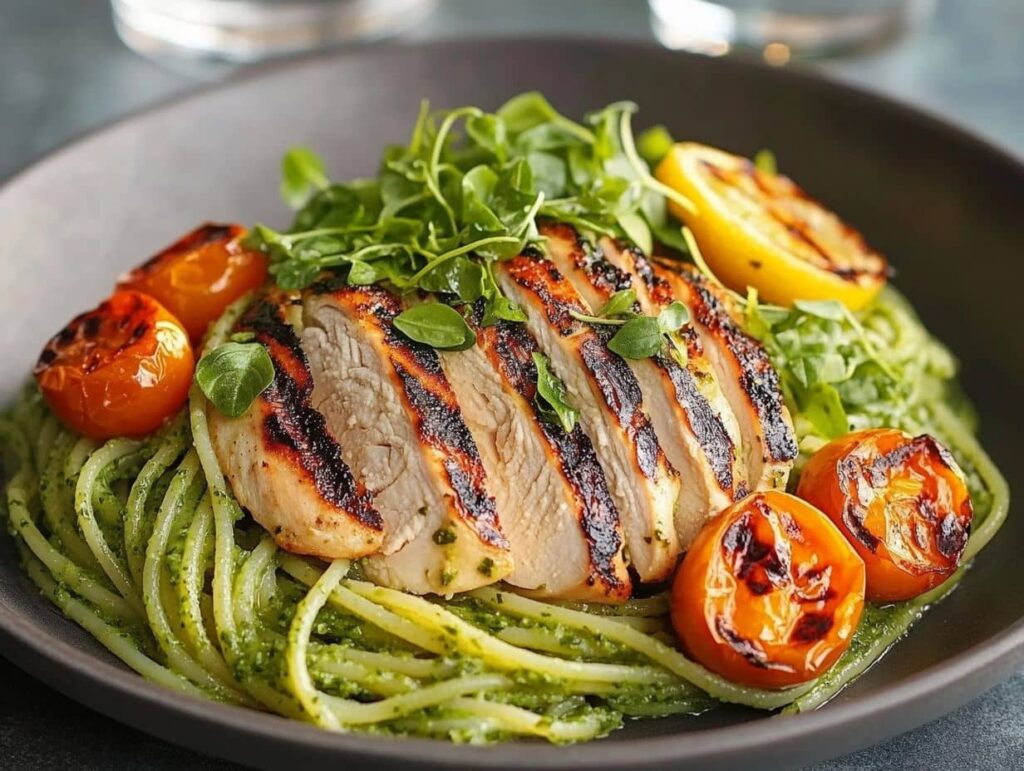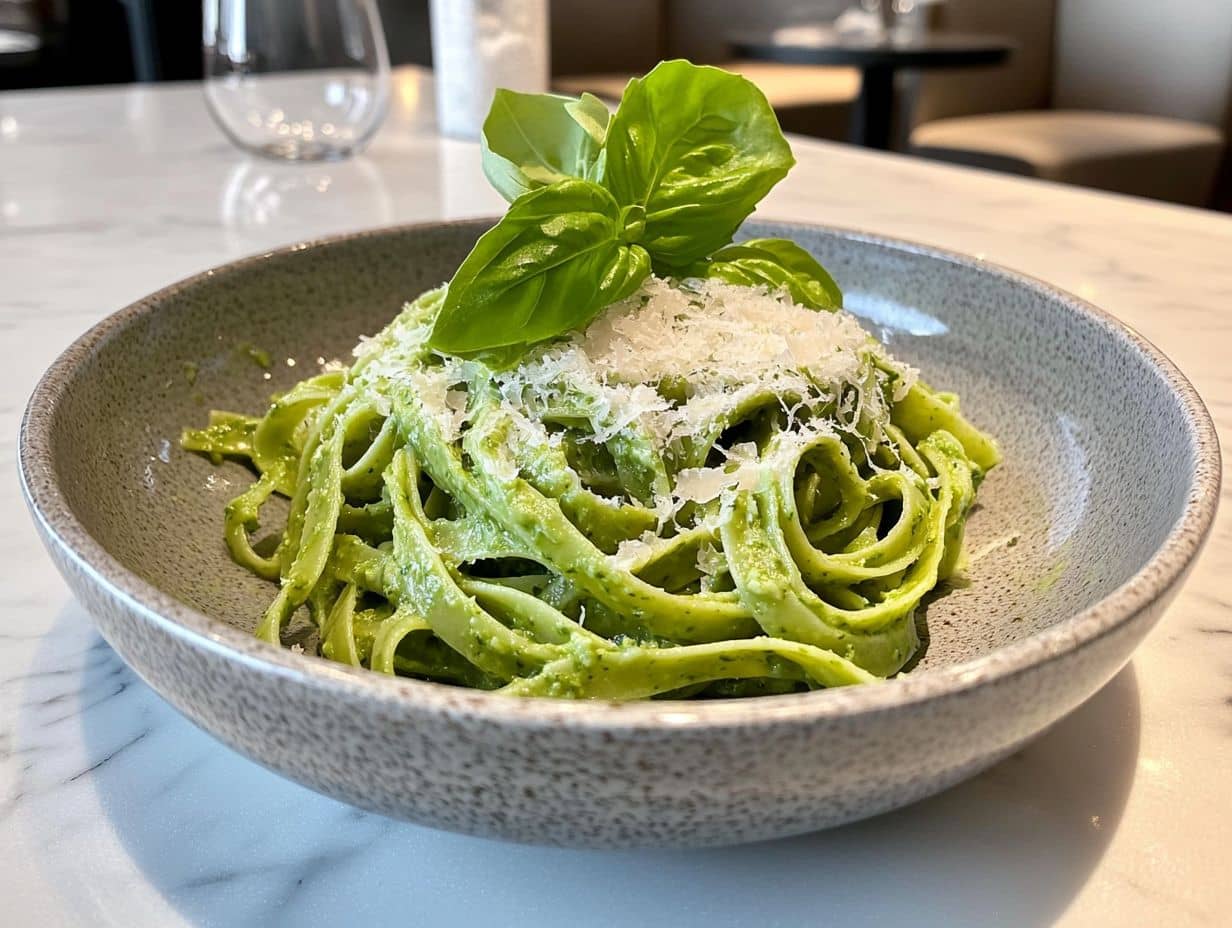Ever wondered what gives that gorgeous, earthy green pasta its hue? If you’ve spotted it on Instagram or in a fancy Italian restaurant, you might’ve thought, “That’s too fancy for me to try!” Well, it’s not. In this guide, we’re diving headfirst into the world of green pasta, from its origins to why it’s so good for you. Whether you’re a pasta newbie or a seasoned foodie, you’re in for a treat! 🍝
What Is Green Pasta?
The Origins of Green Pasta
Green pasta has been a part of Italian culinary traditions for centuries. Cooks infused fresh spinach and herbs into dough to create its signature hue and earthy flavor. Today, green pasta has become a trendy dish, as seen in popular creations like Green Spaghetti for Healthy Pasta Lovers.
What Makes Pasta “Green”? Ingredients and Variations
The secret lies in the greens used in its preparation. Ingredients like spinach, kale, parsley, or even zucchini bring out the vibrant shades. Curious about the different styles? Check out How to Make Green Spaghetti: Ingredients, Recipes, and Tips.
“Green pasta isn’t just food; it’s art on a plate delicious, nutritious, and picture-perfect.”
Why Choose Green Pasta? Benefits and Appeal
Nutritional Benefits of Green Pasta
Green pasta isn’t just gorgeous; it’s also a nutritional powerhouse. Depending on the greens used, it can be rich in vitamins A, C, and K, plus iron and antioxidants. For more inspiration, learn about the family-friendly, non-spicy version in Green Spaghetti Without the Heat: How to Make It Family-Friendly.
| Nutrient | Amount |
|---|---|
| Calories | 200 |
| Protein | 7g |
| Fiber | 4g |
| Iron | 15% of RDI |
| Vitamin A | 50% of RDI |
Aesthetic Appeal: Why It’s Instagram-Worthy
Let’s be honest green pasta is a total showstopper. It adds a splash of color to your plate that looks (and feels) gourmet. Whether it’s a dinner party or just a Tuesday night, serving green pasta feels like a little celebration.
Types of Green Pasta
Spinach Pasta
Spinach pasta is the OG of green pasta. It’s mild, versatile, and works with almost any sauce. Plus, it’s an easy way to trick kids into eating their greens what they don’t know won’t hurt them. 😉
Pesto Pasta
Pesto pasta is all about bold flavors. Made with fresh basil, garlic, olive oil, and parmesan, it’s a zesty and vibrant option that pairs beautifully with proteins or veggies.
Zucchini Noodles: A Low-Carb Alternative
If you’re looking to skip the carbs but still want that green goodness, zucchini noodles (a.k.a. “zoodles”) are your best bet. They’re light, refreshing, and soak up sauces like a dream.
“Green pasta comes in many forms, but each one delivers a little magic on your plate.”
Ingredients for Making Green Pasta at Home
Choosing Fresh and Organic Greens
The fresher the greens, the better the pasta. Spinach, kale, basil, or parsley can all be used. Organic options ensure there are no pesticides, which means more flavor and nutrition.
Essential Pasta-Making Tools
Making pasta isn’t as intimidating as it sounds. Here’s what you need:
- Pasta roller: For that smooth, thin dough.
- Sharp knife or pizza cutter: To cut the pasta into shapes.
- Mixing bowl: Where all the magic starts.
Don’t worry if you don’t have a fancy machine good ol’ rolling pins work too.
How to Make Homemade Green Pasta: Step-by-Step Guide
Alright, it’s time to roll up your sleeves and get a little messy in the kitchen. Making green pasta from scratch isn’t just fun it’s surprisingly therapeutic. Let’s break it down step by step, so you’ll be a pasta pro in no time.
Preparing the Dough
The foundation of great pasta is a well-prepared dough. Here’s what you’ll need:
| Ingredient | Quantity |
|---|---|
| All-purpose flour (or 00 flour for authentic texture) | 2 cups |
| Fresh spinach (blanched and pureed) | 1 cup |
| Eggs | 2 large |
| Olive oil | 1 tablespoon |
| Salt | 1/2 teaspoon |
Steps:
- Make a well: On a clean surface, mound your flour and create a well in the center. Crack the eggs into the well and add the spinach puree, olive oil, and salt.
- Mix and knead: Slowly incorporate the flour into the liquid ingredients using a fork. Once it starts to come together, knead the dough by hand for about 8-10 minutes until it’s smooth and elastic.
- Rest: Wrap the dough in plastic wrap and let it rest for 30 minutes. This allows the gluten to relax, making it easier to roll out.
“The secret to perfect pasta dough is patience and a little bit of elbow grease. Don’t rush the kneading!”
Rolling and Shaping Techniques
Once your dough is rested, it’s time to roll it out. If you have a pasta machine, great! If not, a rolling pin will do just fine.
Steps:
- Divide the dough into smaller portions to make it easier to handle.
- Roll each portion into a thin sheet (about 1-2 mm thick).
- Cut the sheets into your desired shape fettuccine, tagliatelle, or even ravioli.
Cooking Tips for Perfect Texture
Fresh pasta cooks much faster than store-bought varieties. Here’s how to nail it:
- Bring a pot of salted water to a boil.
- Add your pasta and cook for 2-3 minutes, or until it floats to the top.
- Drain and toss with your favorite sauce immediately to prevent sticking.
Fresh pasta is tender and absorbs sauce beautifully, making every bite a flavor explosion. 🍴 Looking for more varieties? Explore The Rarest Spaghetti Explained: Unique Varieties and How to Enjoy Them.
Green Pasta Recipes to Try
Now that you’ve mastered the basics, let’s put your skills to the test with some mouthwatering recipes. These are guaranteed to impress anyone lucky enough to sit at your table.
Classic Spinach Fettuccine with Garlic Butter Sauce
This recipe is a true crowd-pleaser. The simplicity of garlic butter complements the earthy flavor of spinach pasta perfectly.
Ingredients:
- Fresh spinach fettuccine
- 3 tablespoons unsalted butter
- 2 cloves garlic (minced)
- Grated Parmesan cheese
- Salt and pepper to taste
Instructions:
- Cook the pasta as described above.
- In a large skillet, melt butter over medium heat. Add garlic and sauté until fragrant.
- Toss the cooked pasta in the skillet until well-coated. Add Parmesan, salt, and pepper to taste.
- Serve hot and garnish with extra cheese. Voilà!
Creamy Avocado Pesto Pasta
For a healthier twist, this avocado pesto pasta is creamy without the cream. Plus, it’s vegan!
Ingredients:
- Fresh green pasta (spinach or zucchini noodles work great)
- 1 ripe avocado
- 1/4 cup fresh basil leaves
- 2 tablespoons olive oil
- 1 clove garlic
- Juice of 1 lemon
- Salt and pepper to taste
Instructions:
- Cook the pasta and set aside.
- In a blender, combine avocado, basil, olive oil, garlic, lemon juice, salt, and pepper. Blend until smooth.
- Toss the pasta with the avocado pesto until well-coated.
- Serve immediately, and enjoy the creamy, zesty goodness! 🥑
“A good sauce can turn even the simplest pasta dish into a masterpiece.”
Zucchini Noodles with Spicy Basil Pesto
If you’re in the mood for something lighter, this zucchini noodle dish packs a punch with its spicy pesto.
Ingredients:
- 2 medium zucchinis (spiralized into noodles)
- 1 cup fresh basil leaves
- 1/4 cup olive oil
- 1 clove garlic
- 1/4 teaspoon red pepper flakes
- Salt to taste
Instructions:
- In a blender, combine basil, olive oil, garlic, red pepper flakes, and salt to make the pesto.
- Lightly sauté the zucchini noodles in a pan for 2-3 minutes.
- Toss the noodles with the spicy pesto and serve immediately.
Common Problems When Making Green Pasta (and How to Fix Them)
Even the best chefs have off days. If your green pasta doesn’t turn out as expected, don’t worry we’ve all been there. Here are some common issues and how to fix them like a pro.
Why Is My Pasta Too Sticky?
Sticky pasta is usually a result of too much moisture or not enough flour during the dough-making process. Here’s how to fix it:
- Tip 1: Dust your work surface and rolling pin with flour while kneading and rolling.
- Tip 2: If the dough feels sticky, add small amounts of flour until it reaches the right consistency.
“Sticky pasta? Just a little extra flour can save the day!”
What If My Green Pasta Loses Its Color?
There’s nothing sadder than vibrant green pasta turning dull after cooking. This happens if the water is too hot or if you overcook it. Try these tricks:
- Tip 1: Add a pinch of salt and a splash of olive oil to the boiling water to preserve color.
- Tip 2: Cook the pasta for no more than 2-3 minutes and rinse it with cold water immediately after draining.
Dealing with Overcooked or Undercooked Pasta
Overcooked pasta becomes mushy, while undercooked pasta is tough. The solution? Timing is everything:
- Tip 1: Always test a small piece of pasta before draining.
- Tip 2: Set a timer to avoid overcooking it’s better to undercook slightly as the pasta will continue to cook with the sauce.
Pairing Green Pasta with the Right Sauces and Toppings

Green pasta’s delicate flavor deserves the perfect companions. Here’s how to elevate your dishes:
Best Sauces for Spinach-Based Pasta
Spinach pasta shines with light, creamy, or garlic-based sauces. Try these combinations:
- Garlic Butter Sauce: A classic choice that’s simple yet delicious.
- Alfredo Sauce: For a richer, creamier option.
- Lemon Herb Sauce: Perfect for a fresh, zesty kick.
Protein and Vegetable Pairings for Balanced Meals
Make your pasta a complete meal by adding these proteins and veggies:
- Proteins: Grilled chicken, shrimp, or tofu.
- Vegetables: Roasted cherry tomatoes, sautéed mushrooms, or steamed broccoli.
“Pairing the right sauce and toppings turns green pasta into a culinary masterpiece.”
Green Pasta for Special Diets
Green pasta is incredibly versatile, making it easy to adapt for different dietary needs. Here’s how you can enjoy it, no matter your diet:
Gluten-Free Options for Green Pasta Lovers
Don’t let gluten intolerance stop you from enjoying green pasta! Use gluten-free flours like almond flour, rice flour, or chickpea flour. These alternatives work well for both fresh and dried pasta recipes.
Keto-Friendly Green Pasta Alternatives
If you’re cutting carbs, zucchini noodles are your best friend. Pair them with keto-friendly sauces like pesto or garlic butter for a satisfying, low-carb meal.
Where to Buy Green Pasta Ingredients
Finding the right ingredients doesn’t have to be a chore. Here are some tips:
Local Grocery Stores and Farmer’s Markets
Most grocery stores stock fresh spinach, kale, and basil. For the best flavor, check out your local farmer’s market you’ll find organic, vibrant greens there.
Online Retailers for Specialty Ingredients
If you need gluten-free flours, pasta machines, or unique greens like spirulina powder, online retailers have you covered. Amazon, Thrive Market, and specialty food websites are great places to shop.
The Future of Green Pasta: Sustainability and Trends
Eco-Friendly Pasta Production
Many companies are exploring sustainable practices, such as using renewable energy and eco-friendly packaging. By choosing these brands, you can enjoy your pasta while caring for the planet.
Creative Variations Using Alternative Greens
Green pasta doesn’t have to stop at spinach or basil. Experiment with arugula, seaweed, or even edamame for unique flavors and textures. Who knows you might invent the next big pasta trend!
Final Tips for Mastering Green Pasta
Before we wrap up, here are some parting tips:
- Experiment: Don’t be afraid to try new greens, sauces, and pairings.
- Presentation: A sprinkle of Parmesan or a drizzle of olive oil can take your dish to the next level.
- Share: Snap a pic of your creation and share it online you might inspire others to join the green pasta revolution!
“Green pasta isn’t just food it’s a lifestyle. Once you start, there’s no going back!”
Conclusion: Embrace the Green Pasta Revolution
Green pasta is more than just a pretty dish; it’s a celebration of flavor, nutrition, and creativity. Whether you’re making it from scratch or experimenting with new recipes, there’s always something new to discover. So, roll up your sleeves, grab some fresh greens, and get cooking you’ve got this! 🍝
For more tips and recipes, don’t forget to check out How to Make Green Pasta: Step-by-Step Recipes and Tips. Happy cooking!

